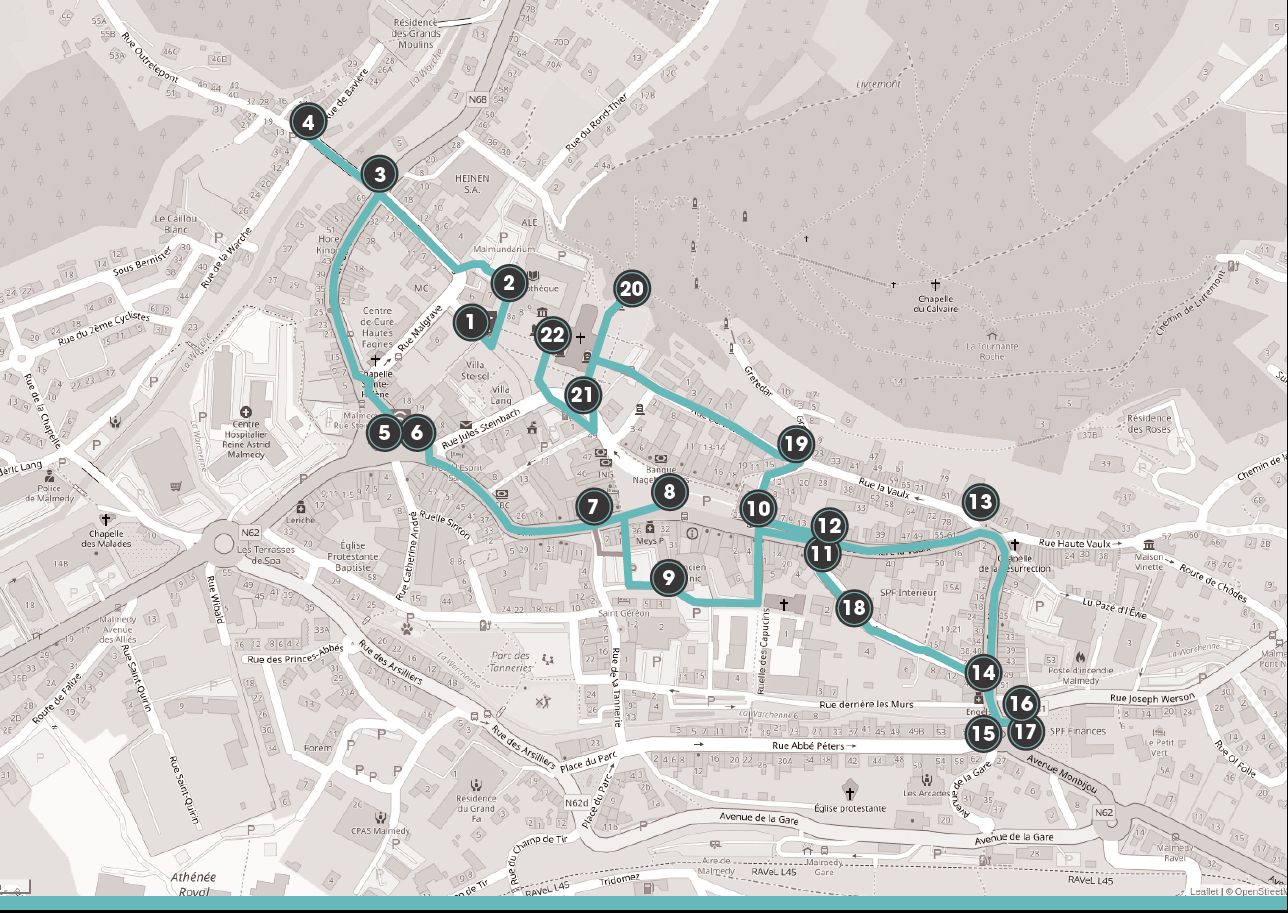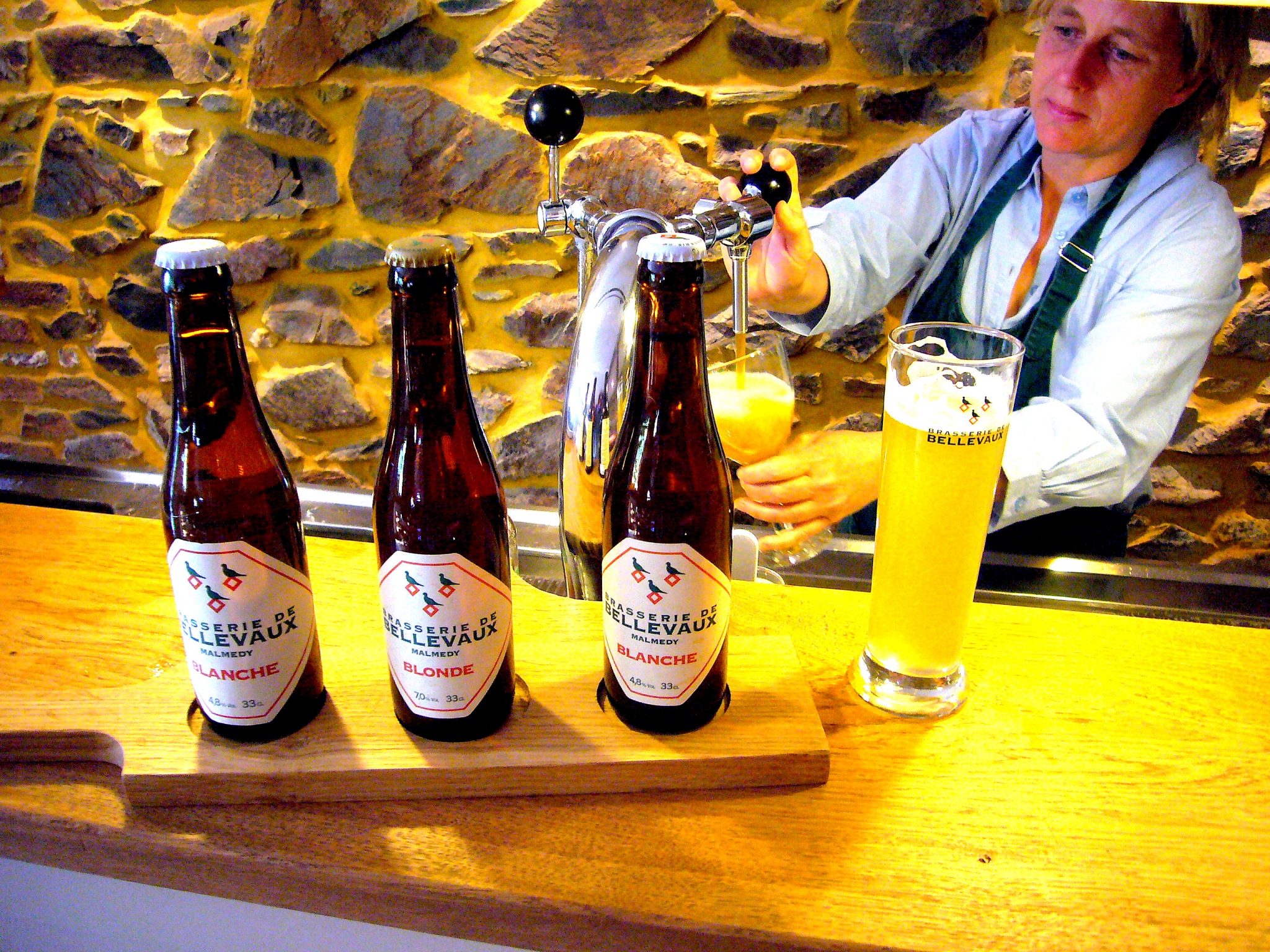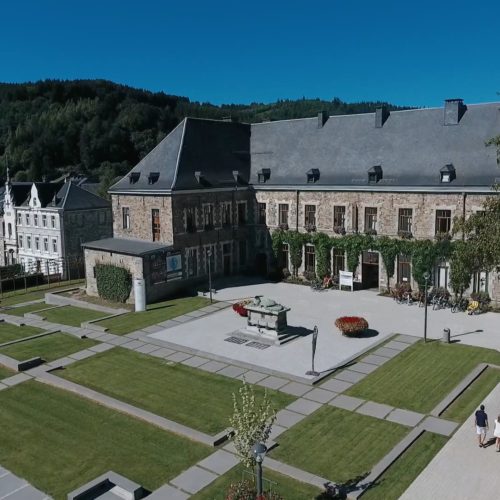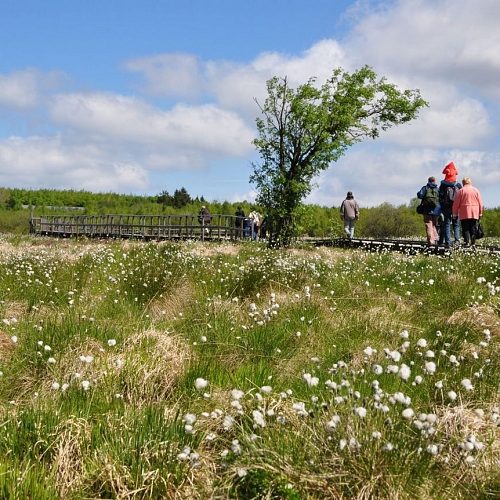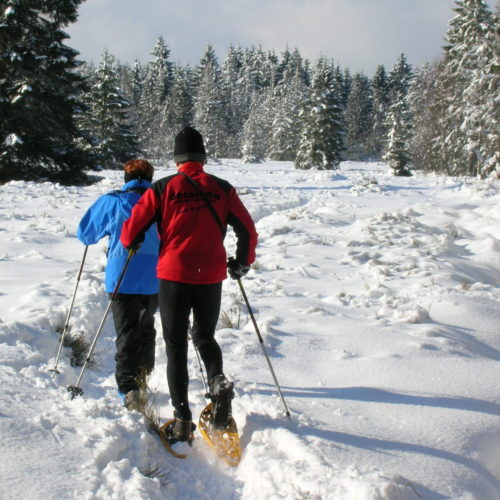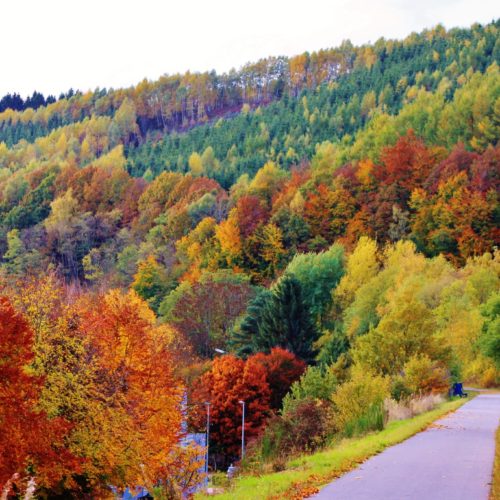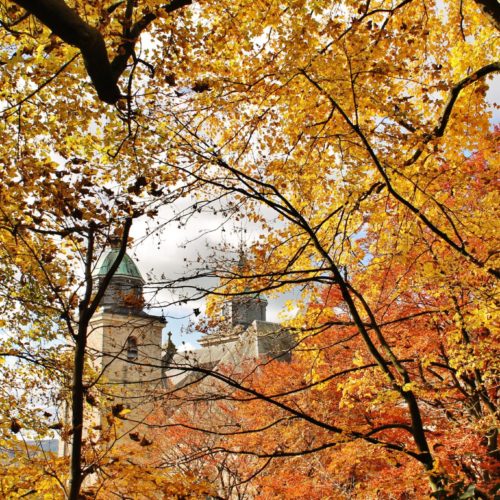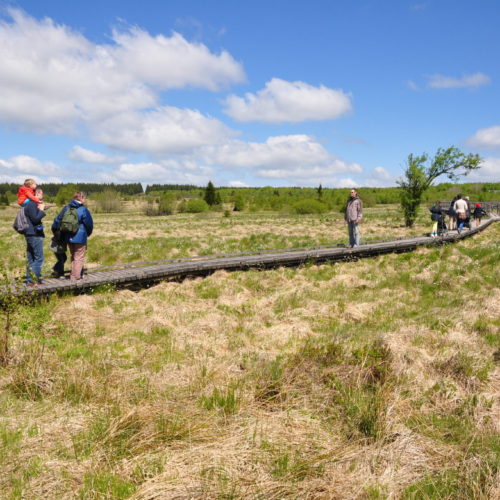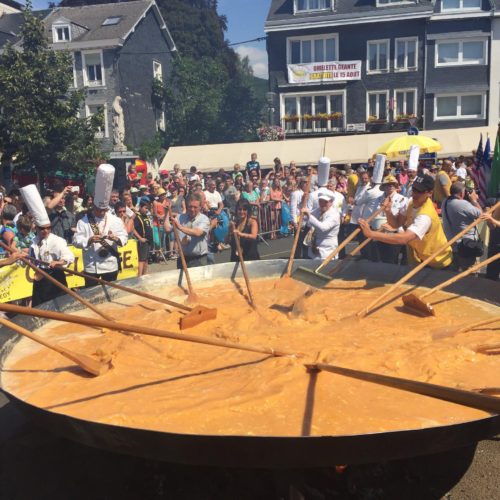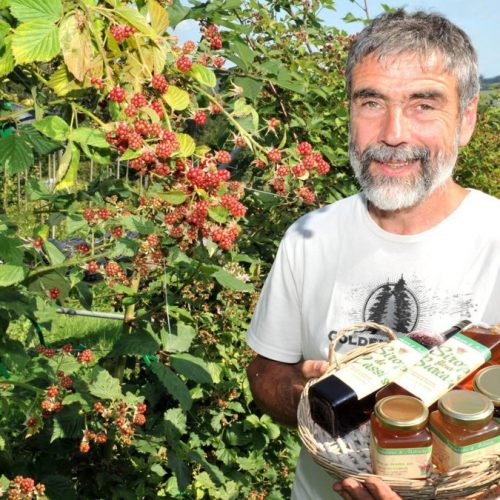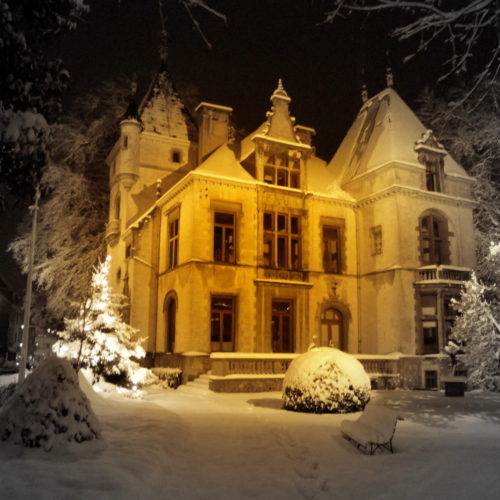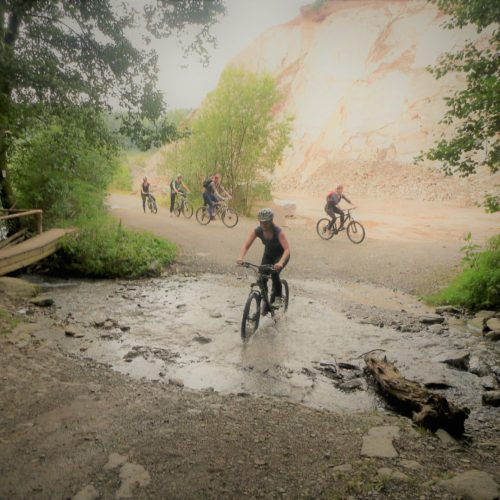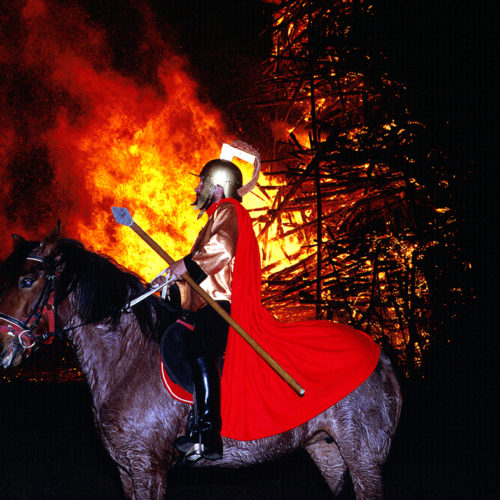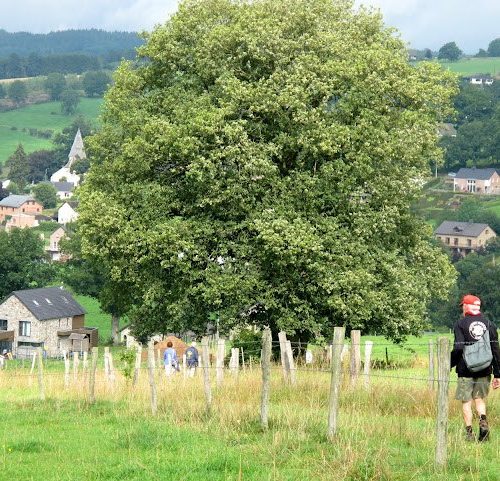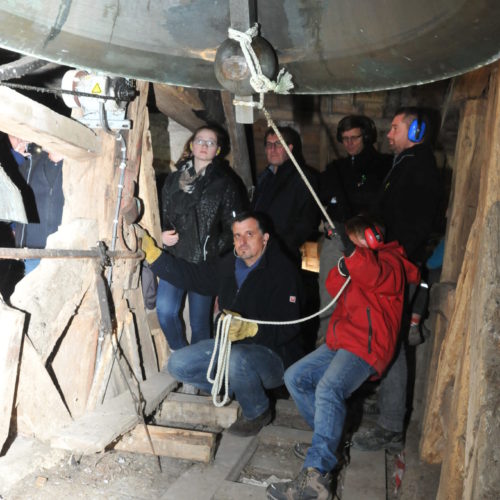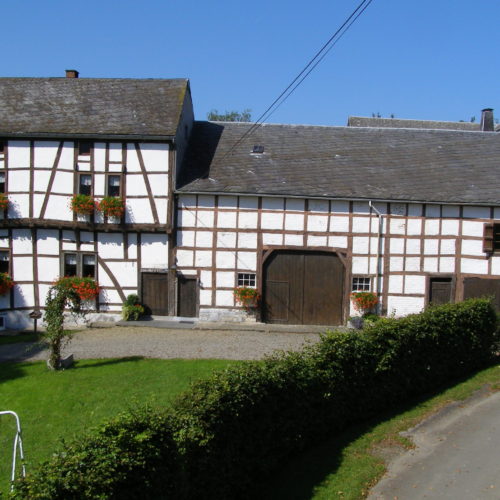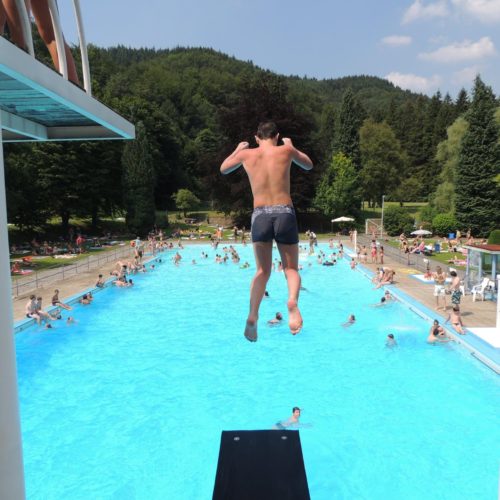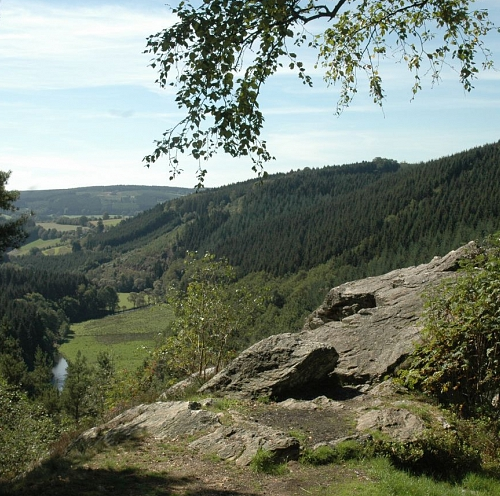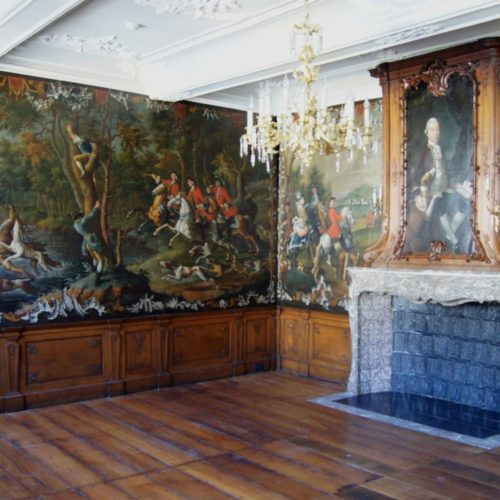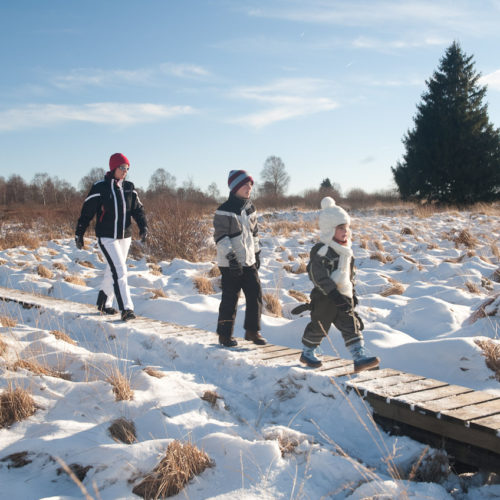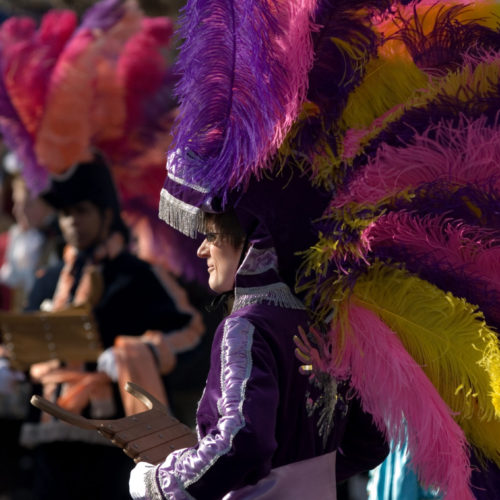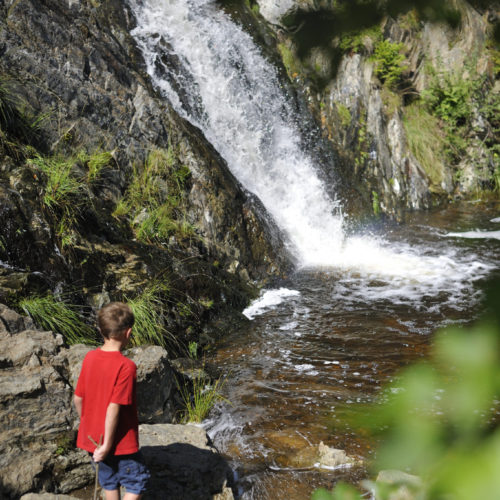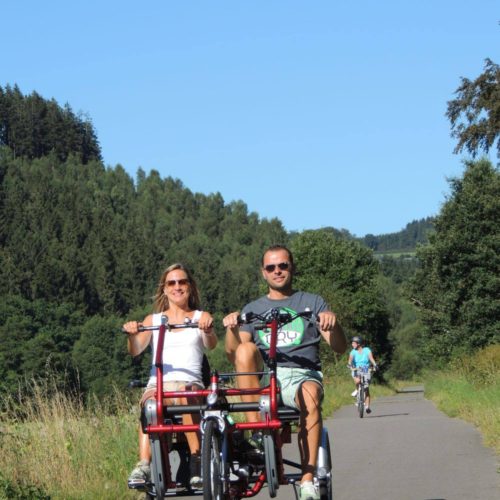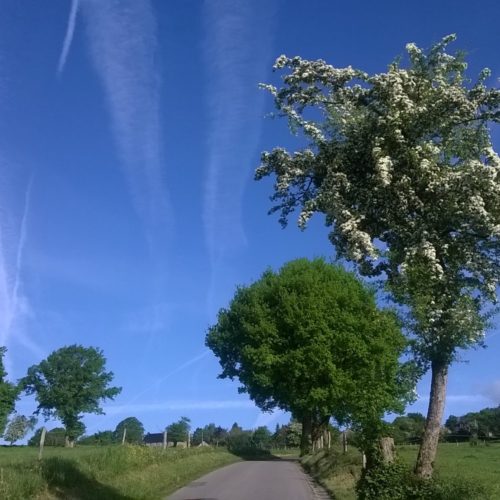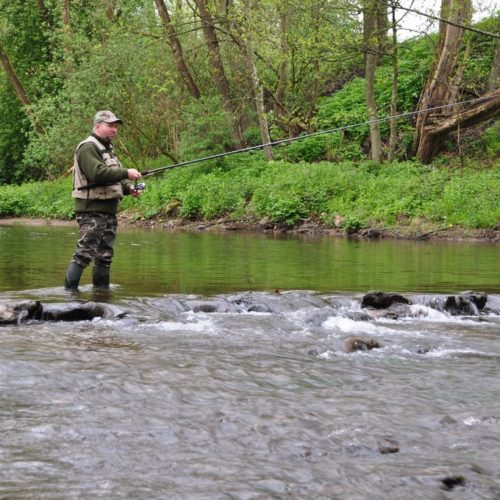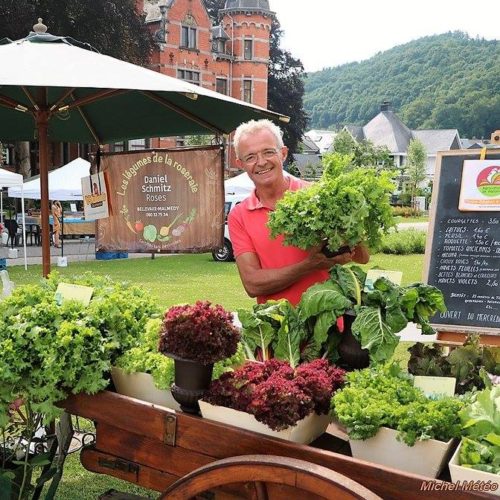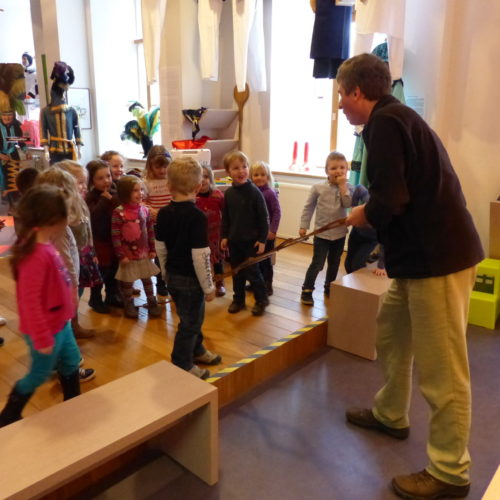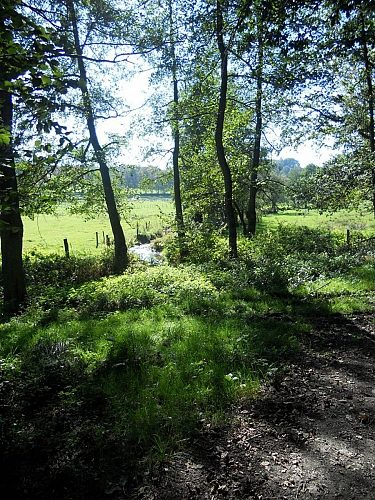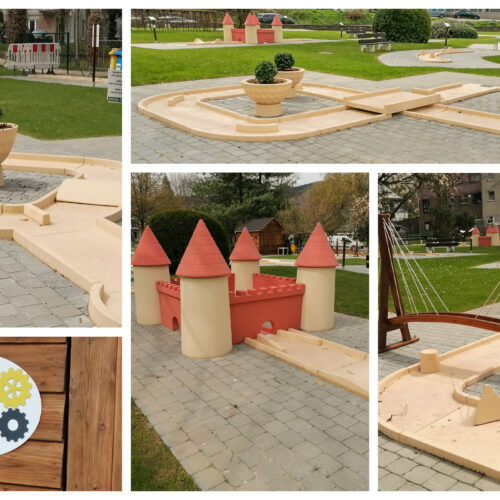Map
Click on the link to view the Malmedy Battle Tour December 44 map in CIRKWI.
Brochure
Click on the link to view the Malmedy Battle Tour December 44 brochure
Malmedy Battle Tour December 44
After more than five years of war and following the Normandy landings in June 1944, which led to the liberation of northern France, Belgium and Luxembourg, Nazi Germany appeared to be defeated. But this was not to be!
In the liberated towns of the Ardennes, the sense of deliverance brought hope to the people. But this was a hope that would soon fade as the cold winter nights drew in. Then, on 16th December 1944, the Battle of the Bulge began. Malmedy would not be spared its full force.
A circuit of 22 photographic panels placed in different parts of Malmedy town centre will help you to relive moments from the town’s tragic story as it unfolded during the winter of 1944/45.
The Battle Tour Malmedy memorial circuit pays tribute to the civilian and military victims of the fighting and bombing of the town in December 1944.
The aim of Battle Tour Malmedy is not only to tell the story of what happened, but also to pass on this painful legacy to future generations and to make them aware of the risks and dangers that come from the establishment of totalitarian or extremist regimes.
A museum space presenting the history of the Battle of the Bulge in our region, the ‘MALMEDY WAR MUSEUM 44’, is in the process of being prepared and will be opened at the end of 2025 t the Malmundarium visitor centre.
Photo 1
Place du Châtelet in front of Villa Steisel – 29/12/44
The roof of Villa Limbourg in the background has been damaged and the chunks of debris scattered on the ground illustrate just how extremely violent the bombing raids on 23rd, 24th and 25th December were. Three soldiers from the 120th Infantry Regiment of the 30th Infantry Division take a break from the fighting. From left to right: Sergeant Lyle Greene (Rochester, Minnesota), Staff Sergeant Joseph DeMott (Greenwood, Indiana) and Private First Class Fred Mozzoni (Chicago, Illinois). All three survived the war.
Photo 2
In front of the Malmundarium – 24/12/44
On Sunday 24th December, the American 291st Engineer Combat Battalion was hard at work in the town centre damaged by the first bombing of the previous day. At around 2.30 in the afternoon, eighteen B24 Liberator bombers approached Malmedy. As on the previous day, the bomb bays opened to release their deadly cargo when the aircraft were over the town. The Athénée (now the Malmundarium), whose sturdy underground cellars provided refuge for around 200 civilians, sustained a direct hit. One bomb exploded right in the heart of the boiler room where many families had taken refuge in search of a little warmth. When the GIs quickly moved in to help the victims, they discovered the carnage: in addition to the many wounded in the blast, 40 people were killed. Fritz Jacob, appointed acting municipal secretary, is wearing an armband bearing the following inscription: V.M.G.P., standing for ‘Ville Malmedy Gouvernement Provisoire’ (‘Town of Malmedy Provisional Government’).
Photo 3
The crossroads of Rue Devant l’Étang, Les Grands Moulins and Rue Cavens – 03/01/45
It’s 3rd January 1945 and Private Gene Heathcoat (photographed by Kitzerow) is directing traffic at the crossroads of Rue Devant l’Étang, Les Grands Moulins and Rue Cavens. The houses damaged during the second bombing on 24th December 1944 are covered with snow.
As you walk along the Rue Devant l’Étang in front of you, you will see a number of impact traces on the red brick façades caused by the explosions.
Photo 4
Outrelepont – End December 1944
From the bridge at Outrelepont, a member of the US Army Signal Corps films the damage caused by the bombing. The Signal Corps is a branch of the US Army whose function is to develop, test, provide and manage communications and information systems for the control and command of combined armed forces.
Photo 5
Place de Rome – 18/12/44
The 743rd Tank Battalion arrives in the Place de Rome on 18th December 1944. The battalion has been recalled from Aachen to counter the German offensive launched on 16th December. The soldiers crossed Eupen and the Fagnes region before spending the night at Xhoffraix. The following day, they set off again for the Stavelot region to reinforce the 30th Division and, more specifically, the 117th Infantry Regiment, which had plenty to do against the SS Kampfgruppe Peiper. The numerous direction signs illustrate the importance of Malmedy for the Medical Corps: Medical Battalion, Medical Supply Dump, 618th Medical Clearance Company. There’s even a sign for the “Exhaustion center” for men suffering from battle fatigue. The essential water supply points are indicated by two signs.
Photo 6
Chemin-Rue – 18/12/44
Reinforcements arrive! It is 18th December, five days before the bombing raids. A Sherman M4A3E2 tank nicknamed ‘Jumbo’ is parked at the entrance to Chemin-Rue. This version of the Jumbo was produced in 1944 to meet the demand for a heavily armoured tank capable of supporting infantry in the battles to come. The tank’s protective armour was reinforced. The factories produced and delivered 128 Jumbo tanks to Normandy in September. In October, they supplied 36 to the First Army.
Photo 7
Chemin-Rue – Maison Villers – 29/12/1944
Maison Villers, a jewel of Malmedy architecture, was miraculously spared by the bombs, unlike the buildings to its right, which were razed to the ground during the first bombing raid on 23rd December 1944. Maison Villers was saved from the fire by the American Corps of Engineers, who blew up the house on the right-hand side to halt the flames spreading from house to house.
Photo 8
Place Albert Ier – Obelisk – 21/12/44
A well-known photo of the American 99th Infantry Battalion, which had the unique distinction of being made up exclusively of Norwegian expatriates living in the United States. They were selected on the basis of their Norwegian ancestry, their knowledge of the language and their ability to ski. Organised as a standard infantry battalion of 886 men, its strength was increased to 1,000 men to enable the unit to operate independently.
In Malmedy, the battalion was attached to the 120th Infantry Regiment, with which it carried out an incredible defensive operation against SS Otto Skorzeny’s Panzer Brigade 150 on 21st December 1944.
Photo 9
Place Saint-Géréon – 23/12/44
This incredible view of the cathedral and Place Albert 1er from Place St. Géréon shows the extent of the damage that occurred on 23rd December, during the first bombing raid. All that remains of the row of houses that separated the two squares is a pile of rubble. The bandstand, built in 1901 in the centre of the square, miraculously escaped the bombs.
Photo 10
Place Albert Ier – 25/12/44
Christmas in hell! On 23rd, 24th and 25th December 1944, Malmedy was bombed by American aircraft. On the ground, it was like the apocalypse had arrived. The whole town went up in flames, houses were pulverised and collapsed like houses of cards and entire roofs were torn off. By the time the emergency services got organised, a steady stream of the bodies of the victims were lined up in the school playgrounds. The human desolation was compounded by difficult weather conditions: snow and cold, as well as problems with heating, electricity distribution and drinking water supplies. The bombings caused the deaths of 220 civilians. The number of wounded is not known. More than 80 American soldiers were also killed and many others wounded. This photograph was taken just after the bombing, the ruins are still smouldering and the road has not yet been cleared.
Photo 11
Place du Commerce towards Rue de la Gare – 18/12/44
On 16th December 1944, the 526th Armored Infantry Battalion was alerted to the German advance. These soldiers had driven all day and into the night of 17th December to reach Malmedy. Their main task was to secure the town’s perimeter. On 18th December, the men of the 526th tried to protect the bridges at Stavelot, Trois-Ponts and Malmedy, although they were greatly outnumbered by the enemy forces. Here we see one of their Dodge 6x6s firing an American M1 57mm anti-tank gun (the American version of the British QF 6-pounder gun).
Photo 12
Rue Derrière La Vaulx – 18/12/44
Photo depicting the arrival of the 743rd Tank Battalion (Company A) in the town centre of Malmedy on 18th December 1944. At that time, Rue Derrière la Vaulx was open to two-way traffic, which is no longer the case today.
Photo 13
Place du Pont Neuf – 25/12/44
During the bombing raids at Christmas 1944, nine members of the Rome family were hiding in the cellar. The children were sitting on sacks of potatoes when a bomb hit their home. Miraculously, no one was hurt. It was American soldiers who evacuated the home’s residents out of the cellar through the window well and who took charge of them. It was the only bomb to hit the upper part of the town.
Photo 14
Rond-Point de l’Octroi – 18/12/1944
Soldiers from Company B of the 120th Infantry Regiment (30th Infantry Division) grab rifle grenades before moving outside Malmedy where sightings of the enemy have been reported. On the left is Lieutenant Earl Johnson, who later became a basketball player, with Sergeant Tony Cardinale on his right. In the centre background is Sergeant Wallace Miller. Fun fact: the soldier holding out his hand in the trailer is wearing a Luftwaffe (German air force) flying helmet.
Photo 15
Pont de l’Octroi – End December 1944
Pont de l’Octroi, December 1944. During the Ardennes Offensive, the bridge over the Warchenne was mined by American engineers. More than 400 kg of TNT were laid to prevent German forces from crossing the river. In the end, the destruction of the bridge was not necessary, as the German forces never managed to penetrate as far as the town centre of Malmedy.
Photo 16
Rond-Point de l’Octroi – Former Landratur – 27/01/45
19th January 1945 and there has been a heavy snowfall. The former Landratur administrative building has housed the headquarters of the 30th Infantry Division since 12th January, when it left the Hôtel des Bruyères in Francorchamps. This photo was taken on 27th January 1945. The gate is guarded by 2 MPs (Military Police). The large building in the background was built between 1912 and 1914 under German rule to house the Landrat (Land Council) and its administration. However, it only had a short life, because after the First World War, the cantons of Eupen-Malmedy and Saint-Vith became part of Belgium. Following the departure of the last Landrat, Lieutenant-General Baron Baltia was appointed Governor of Eupen-Malmedy in 1919. The former Landratur then became the Baltia government centre until 1925. During the Second World War, the building was requisitioned by the Germans, who used it as their administrative headquarters. It was subsequently used for a variety of purposes.
Photo 17
Avenue Monbijou – 18/12/1944
Heavily armed troops of the 120th Infantry Regiment moving along Avenue Monbijou.
30th Division was made up of three regiments (117th, 119th and 120th), with 3,200 soldiers in each regiment. As an emergency measure, following the German attack, the regiments were sent to the region to counter the German offensive. The 120th to Malmedy, the 117th to Stavelot and the 119th around Stoumont and La Gleize. The 30th Division was not only the most heavily engaged division on the European front, with 282 combined days of combat, but it was also voted by the US Army as the best infantry division of the Second World War.
Photo 18
Rue de la Gare – 18/12/44
The US First Army’s plan was very simple: to bring together the 526th Armored Infantry Battalion, the A/825th Tank Destroyer Battalion and the 99th Infantry Battalion (Separate) (minus Able Company) to create a sufficiently powerful combat group. It was placed under the command of Colonel Harold D. Hansen, Commandant of the 99-IB-(S) and his second-in-command, Major Wilford J. Bjornstad. This combat group was given the name of Task Force Hansen. This photo shows HQ Company of the 526th Armored Infantry Battalion with an M-3 Half-track and a Dodge WC-63 parked in the Rue de la Gare on 18th December 1944.
Photo 19
Rue La Vaulx – Petit Vinâve – 23/12/1944
Following the bombings, fires spread rapidly from house to house. To halt their destructive advance, American engineers blew up some of the houses to act as firebreaks. In this particular case, it was the house of the Lienne girls that was unfortunately affected. The empty space left by the destroyed house is still visible on the right-hand side. In Malmedy, it was the 291st and 105th Engineer Combat Battalions that carried out this difficult work.
Photo 20
The bunker
During Christmas 1944, as many as 700 Malmedy residents took refuge in this shelter, victims of the bombing raids of 23rd, 24th and 25th December. As early as 1939, the Malmedy administration had decided to build a number of shelters in anticipation of the approaching war. One of these was dug into the pudding stone of Mme Lang’s garden (Colline du Calvaire). However, due to technical problems encountered with the excavations, the project was never completed. The shelter idea was taken up again a few years later, in 1944, by the Germans, who sensed a potential setback at the end of the war. It was an ambitious project, capable of sheltering 1000 people or more, 235 metres in length and equipped with a certain level of comfort (ventilation, lighting, toilets, benches, beds, etc.), but with no provision for water supply or wastewater disposal. But it was too late to bring such an ambitious undertaking to completion and the project turned out to be a complete fiasco. Although most of the gallery was in fact excavated, it was never completed. So it was then that during those dark days in December 1944, many of the local people in Malmedy sought refuge in this unlikely shelter, enduring appalling conditions (no light, a lack of oxygen, no lavatory facilities, etc.)..
Photo 21
Place Albert Ier – Villa des Tilleuls – End December 1944
This very powerful photograph shows the entrance to Place Albert 1er after the bombings. On the left, the Villa des Tilleuls is partially destroyed and will unfortunately have to be completely demolished. This photo clearly shows the oppressive atmosphere that prevailed in the town.
Photo 22
Place du Châtelet – End December 1944
After the bombings, the health and sanitary situation in the town was dire, with too many wounded to be treated. The local people found it very difficult to find food for themselves and many inhabitants left the town in American trucks. The photo shows civilians boarding Dodge trucks requisitioned for this purpose. Reception centres were set up in Francorchamps, Spa and Huy.

